|
|
|
Sort Order |
|
|
|
Items / Page
|
|
|
|
|
|
|
| Srl | Item |
| 1 |
ID:
064713
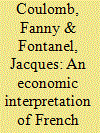

|
|
|
| 2 |
ID:
187352
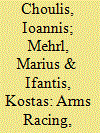

|
|
|
|
|
| Summary/Abstract |
Arms races are linked in the public conscience to potential violence. Following gas discoveries in eastern Mediterranean, Greece and Turkey nearly came to blows in August 2020 and both states have enacted military expansion plans, further risking escalation. We present a novel approach to study the effect of military build-ups on dispute intensity, using monthly data on Turkish incursions into Greek-claimed airspace. Because airspace claims feature strongly in the dispute, these contestations represent an appropriate measure of the intensity with which Turkey pursues the conflict. Theoretically, we suggest that bilateral factors drive this intensity. We argue that increased Greek military capabilities deter incursions whereas increased Turkish military capabilities fuel them. Results from time-series models support the second expectation. Consequently, the study provides a novel methodological approach to studying interstate conflict intensity and shines new light on escalation dynamics in the Greek-Turkish dispute.
|
|
|
|
|
|
|
|
|
|
|
|
|
|
|
|
| 3 |
ID:
118973
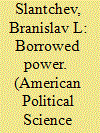

|
|
|
|
|
| Publication |
2012.
|
| Summary/Abstract |
Military expenditures are often funded by debt, and sovereign borrowers are more likely to renege on debt-service obligations if they lose a war than if they win one or if peace prevails. This makes expected debt service costlier in peace, which can affect both crisis bargaining and war termination. I analyze a complete-information model where players negotiate in the shadow of power, whose distribution depends on their mobilization levels, which can be funded partially by borrowing. I show that players can incur debts that are unsustainable in peace because the opponent is unwilling to grant the concessions necessary to service them without fighting. This explanation for war is not driven by commitment problems or informational asymmetries but by the debt-induced inefficiency of peace relative to war. War results from actions that eliminate the bargaining range rather than from inability to locate mutually acceptable deals in that range.
|
|
|
|
|
|
|
|
|
|
|
|
|
|
|
|
| 4 |
ID:
116233
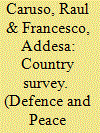

|
|
|
|
|
| Publication |
2012.
|
| Summary/Abstract |
This paper analyses the military expenditures in Italy over the period 1988-2008. The estimation of a conventional model of military expenditure shows that the choices of military expenditure by Italian governments are influenced by US and, to a lesser extent, the other NATO countries' defence spending. In particular, the negative association between the US and NATO average military expenditure on the Italian one suggests a free-rider behaviour of Italy. Eventually, we focus on the relationship between productivity and military expenditure. The results suggest that there is a negative association between productivity and military expenditures in the long run. Namely, if military expenditures were substituted by civilian expenditures, the Italian overall productivity would be expected to improve.
|
|
|
|
|
|
|
|
|
|
|
|
|
|
|
|
| 5 |
ID:
189400
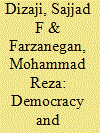

|
|
|
|
|
| Summary/Abstract |
This study examines the dynamic relationship between democracy and the military in more than 40 developing countries from 1990 to 2017. We investigate the dynamic interaction between democracy and military institutions using a panel vector autoregressive model and impulse response functions as well as variance decomposition analyses. We show that democracy plays a significant role in the substitution of nonmilitary expenditures for defense expenditures. We also investigate the response of democracy to positive shocks in military and nonmilitary expenditures. We find that the responses of political systems and different indexes of democracy including electoral, liberal, participatory, deliberative, and egalitarian democracy to positive shocks in military expenditures are negative and significant, whereas their responses to the shocks in nonmilitary expenditures are not significant. This result suggests that the political behavior of governments in developing countries is influenced more heavily by their spending on the military sector than by their spending on the nonmilitary sector.
|
|
|
|
|
|
|
|
|
|
|
|
|
|
|
|
| 6 |
ID:
129496


|
|
|
|
|
| Publication |
2014.
|
| Summary/Abstract |
This study analyzes the determinants of arms production in 15 countries using annual panel data from 1997 to 2002. The results suggest that real GDP per capita, military expenditures, arms exports, and arms imports are positively related to arms production.
|
|
|
|
|
|
|
|
|
|
|
|
|
|
|
|
| 7 |
ID:
002990
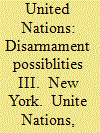

|
|
|
|
|
| Publication |
New York, Unite Nations, 1990.
|
| Description |
167p.
|
|
|
|
|
|
|
|
|
|
|
|
Copies: C:1/I:0,R:0,Q:0
Circulation
| Accession# | Call# | Current Location | Status | Policy | Location |
| 034646 | 327.174/UNI 034646 | Main | On Shelf | General | |
|
|
|
|
| 8 |
ID:
162548
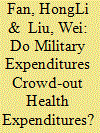

|
|
|
|
|
| Summary/Abstract |
The paper examines the relationship between health and military expenditures using pooled cross-sectional (197 countries) and time series (2000–2013) data. Simultaneous equation models were employed to estimate the relationship between an array of public sector expenditures in order to address potential endogeneity. Our empirical findings strongly support the crowding-out hypothesis whereby increased military expenditures reduce the capacity of government to direct expenditures to health expenditures. These findings were robust to alternative specifications explored in the sensitivity analyses. Compared with upper-middle-income countries, the crowding-out effect became more pronounced among lower-middle-income countries. Consequently, this study shows that increased military expenditures negatively impacts health expenditures, and therefore poses as an important risk factor for population health and individual well-being. Moreover, it is the poorest of nations that are most sensitive to the negative effects of increased military expenditures.
|
|
|
|
|
|
|
|
|
|
|
|
|
|
|
|
| 9 |
ID:
028285
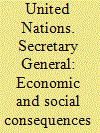

|
|
|
|
|
| Publication |
New York, United Nations, 1972.
|
| Description |
xiii, 51p.
|
|
|
|
|
|
|
|
|
|
|
|
Copies: C:1/I:0,R:0,Q:0
Circulation
| Accession# | Call# | Current Location | Status | Policy | Location |
| 010717 | 355.82/UNI 010717 | Main | On Shelf | General | |
|
|
|
|
| 10 |
ID:
096268
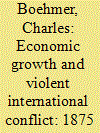

|
|
|
|
|
| Publication |
2010.
|
| Summary/Abstract |
Are states with growing economies more likely to become involved in violent interstate conflicts? This project examines whether economic growth increases international conflict using a global sample of states from 1875-1999. The theory argues that multi-year economic growth increases the resolve of state leaders to reciprocate and escalate militarized interstate conflicts, thus increasing the occurrence of fatalities or war. The results show that economic growth, but not growth of military expenditures, raises the risk of violent interstate conflicts. The results do not support the proposition that economic slowdowns result in violent interstate conflicts.
|
|
|
|
|
|
|
|
|
|
|
|
|
|
|
|
| 11 |
ID:
153087


|
|
|
|
|
| Summary/Abstract |
Strategic interactions between countries, such as arms races, alliances and wider economic and political shocks, can induce strong cross-sectional dependence in panel data models of military expenditure. If the assumption of cross-sectional independence fails, standard panel estimators such as fixed or random effects can lead to misleading inference. This paper shows how to improve estimation of dynamic, heterogenous, panel models of the demand for military expenditure allowing for cross-sectional dependence in errors using two approaches: Principal Components and Common Correlated Effect estimators. Our results show that it is crucial to allow for cross-sectional dependence, that the bulk of the effect is regional and there are large gains in fit by allowing for both dynamics and between country heterogeneity in models of the demand for military expenditures.
|
|
|
|
|
|
|
|
|
|
|
|
|
|
|
|
| 12 |
ID:
156658


|
|
|
|
|
| Summary/Abstract |
Using the latest spatial econometric techniques and data pertaining to 144 countries over the period 1993–2007, this article tests and compares four frequently used spatial econometric models and eight matrices describing the mutual relationships among the countries, all within a common framework, which helps clarify the impact of neighboring countries on military expenditures. Furthermore, it utilizes two different data sources. Due to this setup, it provides one of the most thorough spatial analyses of military expenditures so far. Furthermore, it confirms but also challenges the results of several previous studies. Military spending measured as a ratio of GDP in one country indeed depends primarily on the spending of other countries, but in a limited number of cases, it also depends on control variables that can be observed in other countries, among which are the level of GDP, the occurrence of international wars, and the political regime. The most likely specification of the matrix describing the relationships among countries is the first-order binary contiguity matrix based on land or maritime borders, extended to include two-sided relationships among the five countries that are permanent members of the UN Security Council and one-sided relationships to all other countries. Finally, cross-sectional approaches are rejected in favor of dynamic spatial panel data approaches due to their controls for habit persistence, country, and time-period fixed effects.
|
|
|
|
|
|
|
|
|
|
|
|
|
|
|
|
| 13 |
ID:
175312
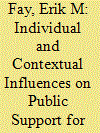

|
|
|
|
|
| Summary/Abstract |
What factors at the individual and country levels influence public support for increased levels of military spending and related foreign policy preferences in NATO countries? Specifically, what individual-level characteristics (e.g., view of NATO) are associated with support for increasing military spending within the NATO alliance, and what country characteristics are associated with shifts in public opinion due to changes in the contextual environment within each country (e.g., military spending/economic growth)? Answers to these questions fill an important gap in the literature by investigating the domestic constraints that influence a country’s response to questions of ‘burden-sharing’ and free riding within NATO. This study examines how citizens’ preferences respond to their domestic political environment, and whether this behavior aligns with the ‘guns versus butter’ trade-off. Findings from a multilevel model combining country-level data with survey data from 13 NATO member countries between 2004–2012 suggest that individuals who view NATO as essential are consistently more likely to support increases in military spending, but changes in the contextual environment, such as high levels of military spending or high levels of economic growth, alter the preferences of individuals in a manner that follows what is known about the trade-offs citizens make between ‘guns versus butter.’
|
|
|
|
|
|
|
|
|
|
|
|
|
|
|
|
| 14 |
ID:
076428
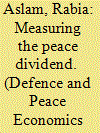

|
|
|
|
|
| Publication |
2007.
|
| Summary/Abstract |
The paper attempts to trace the nexus between defense spending and economic growth in developing countries, using data for 59 developing countries from 1972-2000. The purpose is to measure the opportunity costs of defense spending mainly in terms of alternative public programs. The correlation of social sector expenditures with growth rate as well as the extent of correlation between social and defense sector spending is not clear in the majority of developing countries. It follows that even if defense spending is reduced, the prospects for a peace dividend in the aftermath of the Cold War might be inhibited by political interests that oppose increases in social sector expenditures. If so, defense cutbacks might not lead to a welfare windfall as is generally presumed. Accordingly, this paper tests whether a defense spending cutback will enhance funding for other public programs and whether such a reallocation of resources will prove to be beneficial for the long-term growth rate of the economy
|
|
|
|
|
|
|
|
|
|
|
|
|
|
|
|
| 15 |
ID:
164525
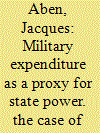

|
|
|
|
|
| Summary/Abstract |
This paper attempts to build a simple indicator of state power. Military expenditure is the paper’s point of departure, with the definitions given by NATO, SIPRI and others. This definition is discussed and a power version is build, using French budgetary data. Then a defence of the result against traditional or non-traditional critics is presented under an imperative of action. Finally, this concept is enlarged and a new concept of power expenditures is given, one more time using French budgetary data. The conclusion is that this large expenditure concept is an unbiased but imperfect indicator of the will to act, and has to be completed by GDP to indicate the capability to act in the long-run.
|
|
|
|
|
|
|
|
|
|
|
|
|
|
|
|
| 16 |
ID:
153085
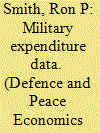

|
|
|
|
|
| Summary/Abstract |
This paper discusses some of the methodological issues involved in analysing military expenditure data, with particular reference to the extended SIPRI data-set. The discussion is organised under the headings of validity, what is the appropriate concept to measure? reliability, how well is it being measured? and comparability, is the same thing being measured over time and space? The paper then considers some of the econometric issues involved in the use of such data.
|
|
|
|
|
|
|
|
|
|
|
|
|
|
|
|
| 17 |
ID:
177826
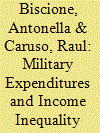

|
|
|
|
|
| Summary/Abstract |
This paper contributes to the literature on military spending by analyzing the relationship between military spending and income inequality in a panel of transition economies over the period 1990–2015. In particular, we exploit three different measures of military expenditures: (i) military spending in absolute terms; (ii) military expenditures per capita; (iii) military burden, namely the ratio between military expenditure and GDP. Findings highlight a positive relationship between military expenditures and income inequality captured by means of three different measures of inequality. Results are also confirmed after we performed a variety of robustness tests. Other results are worth noting and somehow puzzling. For example, military conscription appears to have a redistributional effect and when considering a non-linearity the results show that there could be a concave relationship between military spending and income inequality. In addition, when testing for the ‘crowding-out argument’ results show that expenditures for subsidies are negatively influenced by military spending so confirming the crowding-out argument but there is no significant evidence when considering education and health expenditures.
|
|
|
|
|
|
|
|
|
|
|
|
|
|
|
|
| 18 |
ID:
019768
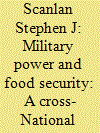

|
|
|
|
|
| Publication |
March 2001.
|
| Description |
159-187
|
|
|
|
|
|
|
|
|
|
|
|
|
|
|
|
| 19 |
ID:
153457
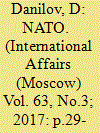

|
|
|
|
|
| Summary/Abstract |
PRESIDENT OF THE UNITED STATES Donald Trump called NATO an obsolete organization and demanded that the European allies should contribute bigger "fair shares" to European security. This includes, among other things, total fulfillment of their obligation to steadily raise their share of military expenditures up to 2% of their GDPs. This caused consternation among the European leaders and the fears that America's role and guarantees would be eroded, transatlantic unity weakened and the role of NATO undermined. Trump's unconditional acceptance of Brexit as the Brits' wise move fanned doubts in the new American administration's wholehearted devotion to the strategic alliance with Europe/EC and its ability to remain NATO's responsible leader.
|
|
|
|
|
|
|
|
|
|
|
|
|
|
|
|
| 20 |
ID:
186521
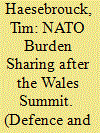

|
|
|
|
|
| Summary/Abstract |
At the 2014 Wales Summit, the NATO allies pledged to spend at least 2% of their GDP on defence by 2024. While some allies are on track to meet the 2% target, others only modestly augmented their military expenditures and still others have even reduced their defence budgets. This article aims to explain the diverging trajectories of the allies’ military expenditures during the first five years after the Wales Summit. More specifically, it introduces an integrated burden sharing model, which is tested with generalized set Qualitative Comparative Analysis. The results of the analysis indicate that the threat posed by Russia provided the most important incentive for increasing defence budgets. However, general budget constraints kept some allies from increasing their defence budget in proportion to the threat posed by Russia. Conversely, in the absence of budget constraints, allies governed by a right-leaning executive made intermediate budget efforts even if they only faced a low level of threat. Strikingly, budget inertia only had a modest impact on the allies’ defence budgets, only resulting in a low level of spending in allies that were not threatened by Russia and either faced considerable budget constraints or were governed by a left-wing government.
|
|
|
|
|
|
|
|
|
|
|
|
|
|
|
|
|
|
|
|
|